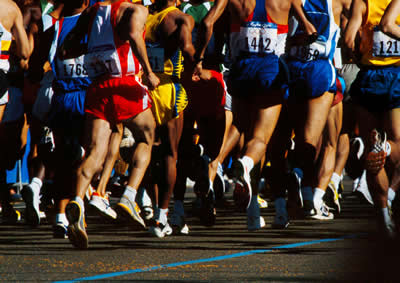by Gina Kolata in NY Times Health
I used to run with a GPS watch, and at the time it seemed like a technological marvel.
Made by Polar, Garmin, Nike and Timex, global positioning system watches track the distance you have run and your pace, including your average pace and your instantaneous pace. They beep at intervals, like every mile, if you want to train by doing some segments of your course at a faster pace. And when you are finished running, you can download all your data onto your computer.
But after a while, I noticed something disconcerting. My watch might record my run as, say, six miles, but according to Google Maps, the actual distance was more like 6.5 miles.
That kind of discrepancy, of course, plays havoc with your training. The pace calculated by the watch is much too slow, and the run becomes an exercise in frustration.
So I got another watch, from a different maker. It was just as bad, maybe worse. I returned it and got a third one, but that one seemed to be absolutely accurate only once, when I was running along the lakefront in Chicago, under a clear sky with no tall buildings and few trees nearby.
On Sunday, I tried a little experiment with friends who also have GPS watches. I started from my house, and Jen Davis and Martin Strauss started from her house; we met up along the way.
My route was 15.96 miles, according to Google Maps. My watch said it was 15.54. Jen's watch, an older model, did much better. Her route was 19.1 miles. Her watch said 19.02.
Race organizers know this problem all too well. Douglas Thurston, operations director for the Competitor Group, which organizes Rock 'n' Roll Marathons, a series of races across the country, braces himself for complaints with every race.
Runners who wore GPS watches start e-mailing him or posting comments on Facebook or Twitter afterward. The course was measured incorrectly, they will say. According to their GPS devices, it was too short.
Mr. Thurston has gotten so used to the complaints that he actually has a generic e-mail reply. No, it says, the course was not wrong. Your GPS device was.
"If someone wants to go to mat on it, I ask them to go to a 400-meter track and run on the inside lane for 12.5 laps. That's 5,000 meters," he said in an interview. Then, he tells the runner, check the distance on your GPS device. He guarantees it will not be 5,000 meters.
Martin illustrated this for me recently by running five times around a track at the University of Michigan, where he is a professor of mathematics and electrical engineering and computer science. When he downloaded the GPS data onto his computer, every loop around the track was a little different, and none were oval.
In fact, not one of his paths was even curved - they were short segments of lines connected to resemble an oval. Yet he had run in the same lane.
It seems clear enough that a GPS watch is not very accurate, yet online runners' forums, like one at the Web site of Runners World, are filled with comments from confused athletes who rely on the devices. One poster, for example, ran a half marathon and wore a GPS watch that said the distance was 12.8 miles instead of 13.1.
"Many people are posting on the race's Web site that theirs came up just as short," the runner wrote. "I got a pretty stellar PR" - personal record - "and would hate to have a question mark hanging over it."
Another wrote, "I did an out-and-back run on a rail trail: 5.25 miles out and 5.02 miles back. According to the GPS, I was running 40 m.p.h. for over two minutes."
What's wrong with those GPS devices? The problem, say their makers, is that people expect too much. The watches are very much a work in progress. "We all use pretty much the same technology," said Corey Cornaccio, director of marketing at Polar. The technology is improving, but some inaccuracy remains. "People don't understand that," he said.
Trees or clouds or tall buildings can block the satellite signals needed for the devices to track distances. Routes with lots of turns throw them off, too; if you lose the signal as you go around a curve, your device will draw a straight line from where it last saw you to where it found you again. The distance around the curve will not be tracked.
Also, says Martin, there is an accuracy problem caused by something called multipath. "If a satellite signal arrives directly and also bounces off a mountain or nearby building to the receiver, the receiver may be confused as to which signal to use," he said.
Then again, we had perfect conditions on Sunday - a sunny day, a route with few turns on country roads lined mostly with fields. And my GPS watch still was wrong.
And even though the technologies - and sources of error - are pretty much the same across different devices, they can give sometimes wildly different results, as one runner, 21-year-old Allen Helton, of Richardson, Tex., discovered. Mr. Helton, a college student who works at a running store, recently decided to test GPS watches sold by different makers, older and newer models, on a variety of courses.
All got distances wrong, and none agreed with the others on any of Mr. Helton's tests. But their worst performance was, as Mr. Helton expected, on a trail run, with trees and twists and turns.
The actual distance was 6.6 miles, and his actual pace was 7 minutes, 37 seconds a mile. The watch that did best said he ran 6.45 miles at a 7:47 pace. The one that did worst said he ran just 5.5 miles at a 9:08 pace.
But Mr. Helton is not throwing his watches away. He has three GPS watches and uses one nearly every time he runs. Then again, unlike most areas where I run, his routes do not have large trees, winding roads and poor satellite reception. On his routes, Mr. Helton said, his GPS device is accurate to within 10 feet of where he actually is.
"To me, that is a very, very accurate watch," he said.




 When you send in your race results, please include the following: Name of race, date of race, your age, time, any age group award. Thanks
When you send in your race results, please include the following: Name of race, date of race, your age, time, any age group award. Thanks
 If you take pictures at club events or already have pictures of recent club events/races, we have set up a Picasa web account for club members to use. This will enable the Club to keep an archive of pictures in one location which will be viewable by everyone. If you are interested in uploading pictures to our site, contact me and I will give you the login information. Click
If you take pictures at club events or already have pictures of recent club events/races, we have set up a Picasa web account for club members to use. This will enable the Club to keep an archive of pictures in one location which will be viewable by everyone. If you are interested in uploading pictures to our site, contact me and I will give you the login information. Click 